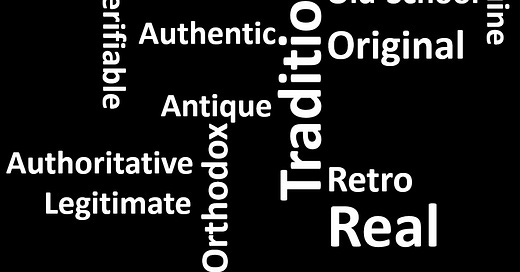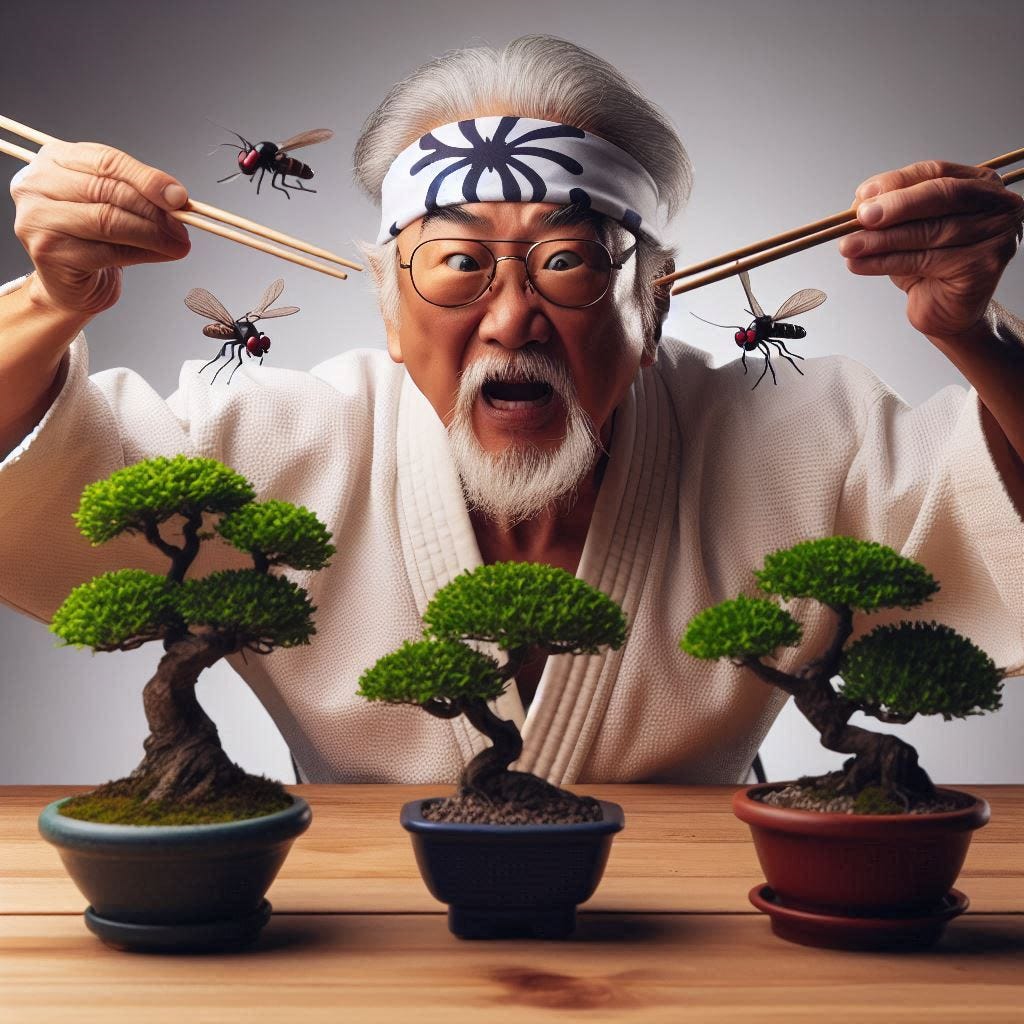‘Traditional’, call it a label of convenience; call it a handy pigeonhole to categorise what is done. You can even use it as a hallmark of quality, if you want. But how helpful is it, and who cares anyway?
Clearly some people care, or they wouldn’t keep using it. Some wear it as a badge of honour. To the detractors and critics it becomes yet another thing to take a swing at, a convenient target, their favourite strawman.
What does ‘traditional’ mean?
A key part of my college training was to look at the early history of advertising; selling through the message and labels were important. We were told that if you wanted to sell something to the Americans you attached the words ‘New Improved’ to it; but if you wanted to sell to the British you were better off using the word, ‘Traditional’. (‘Traditional Marmalade’ gets my vote every time).
I was listening to a political podcast recently in which ex-politician Nick Clegg was asked what it was like working in Silicon Valley (he has a top job with Meta). Clegg said that the interesting thing about the Valley was that everything is focussed on the future; because the industry has no past. He contrasted that with the UK where he was of the opinion that some of the Brits from the hard right were so sucked into a mythical image of Great Britain’s past (one that never existed in the form they assumed) that they seem unable to develop any forward-thinking future ambitions; other than turning it into some kind of warped image of a fictional England.
The past is not only ‘a foreign country’ (as L. P Hartley said) but it’s also inclined to be a toxic swamp.
So why, in martial arts, do we give ‘tradition’ so much kudos?
In the martial arts we make an assumption that it’s because the product was tried and tested, like some historical Darwinian quality control exercise. There is one obvious flaw with that idea; the assumption that the process is continued forward in an unbroken line.
The great crucible that was the hundreds of years of Japanese civil wars is a prime example. For the development of martial skills this wasn’t the steady civilised and disciplined refinements found later in the Edo Period, no this was a total meat grinder. (The battle of Sekigahara in 1600 had an estimated body count of 30,000). It was closer to chaos than it was to organised tradition.
What we know of the surviving Koryu (Old School Budo/Bujutsu), the majority of them were developed and coalesced in the later periods of peace, when they had the luxury of evolving their lineage and traditions, uninterrupted by warfare. This doesn’t lessen their fighting ability (unless the lineage is allowed to drift into decay, as has happened), if anything it gave them scope to really refine the skills and imbue them with a greater humanity – which is always paradoxical in martial arts.
The specific case of karate.
Karate as it is consumed in the West (and in Japan) is a modern thing. Can we attach the word ‘tradition’ to something that is so recent?
In Japan it’s classified as ‘Gendai Budo’, 現代武道 ‘Modern Martial Way’. A line is drawn at 1868; in the years before that it’s ‘Koryu’.
Karate jumped from the rural domain of Okinawan to mainland Japan in the 1920’s and underwent many changes; including elements of militarisation, modernisation and westernisation (consider the influence of the Olympic ideas of Baron De Coubertin which spread across Japan). So, although you might talk about the ‘Olympic tradition’, it would be odd to start referring to ‘Traditional Olympics’ because it would sound so retrograde.
Cobra Kai.
To highlight the clash between traditional and new; modern western culture has set up a cartoonish karate model as a framework to attach a storyline to, which began in 1984 with the springboard of the ‘Karate Kid’ movie franchise and has been warmed over like turkey dinner for the streaming platform generation.
For those of you who know it (and those who don’t):
In a nutshell; Cobra Kai = modern progressive karate, American style, strip mall Dojo, all noise and thunder and no morals.
Miyagi Ryu = Old-fashioned (traditional) karate, clear link to a Japanese/Okinawan figurehead, high moral standard, set up as an antidote to the above. Looks a lot like Goju Ryu (deliberately).
Cobra Kai leader, John Kreese, All-American military guy, Mr ‘No Mercy!’, ‘No fear!’ The cinema-going audience know this is ‘black hat, white hat’ stuff, they are supposed to be repelled by this version of ‘modern karate’.
Miyagi Ryu master, Mr Miyagi; unassuming handyman dude, reluctantly acts as karate mentor to teenager Daniel LaRusso. Indeed, for most of the story Daniel is his only student. The writers have fun with Mr Miyagi’s unorthodoxy, e.g. “In Okinawa, belt mean no need rope to hold up pants”. Miyagi is so traditional, he’s beyond traditional.
Cobra Kai is shown as what the west has done to the noble Japanese tradition, not only have they sportified it, they have taken the humanity out of it.
The critics and the naysayers.
Critics of traditional karate today are also keen to present it as a kind of emasculated formalism, but lacking the military fighting toughness of Kreese’s Cobra Kai (in the movie and the series Cobra Kai had to be presented as a formidable adversary for Daniel San and Miyagi Ryu).
These same critics are also inclined to lazily lump any karate Dojo that dares to use the word ‘traditional’ into the same pigeonhole.
Reading around this subject online I found other phrases being used to describe karate that harked back to late 19th century, early 20th century, like ‘old style karate’, as if inventing a new category that none of us had ever thought of.
Digging deeper I tried to find out just what made this ‘old-style’ so elevated in the eyes of the critics. In their mind it came down to a couple of things:
· All fighting is close-range. Fair enough; but the assumption is that nobody ‘traditional’ does ‘close-range’, which is blatantly untrue (besides, close-range can happen at any point in an engagement).
· Old-style karate involves; atemi waza (which, incidentally, is all over Wado), joint locks, throws, chokes and strangles and ground techniques. I’m sorry but that entire list is what you would find in a reputable school of jujutsu. My advice; leave karate alone, you’d get more fulfilment from late 20th century modern jiu jitsu.
In stating this, in no way am I saying that the universal picture of what people want to call ‘traditional karate’ is a paragon of efficiency and is fully living up to the promises that everyone puts on their websites. It’s a spectrum; some Trad Karate is fabulous, active, realistic, empowering and above all honest. While the other end is just lacking in integrity, a pantomime, a childish parody of karate-like activities and just plain execrable. But isn’t that just the way of most things?
As a final thought…
Black and white thinking turns the whole world into monochrome – give me Technicolor any day.
I will be returning to this theme and coming at it from a different angle in a later piece. Keep your eyes open.
If you enjoyed this article do subscribe for free posts in your inbox every Tuesday. Or consider becoming a paid subscriber for full access to the more in-depth pieces and the growing archive of material sitting behind the paywall.






Good article, thank you. J
It's all subjective. Buyer (practitioner) beware.